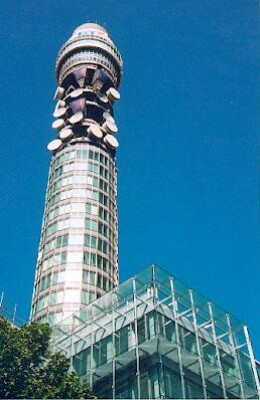 The B.T. (Post Office) Tower was officially opened by Prime Minister Harold Wilson on 8 October 1965. Its purpose was to act as the hub of a nationwide network of microwave relay stations. This network was built to handle the rapidly increasing use of telephone and television in the late 1950s and early 60s. The tower exemplified Wilson’s vision of a new Britain forged from the ‘white heat of technology’. At 189 metres (620 feet), it was the country’s tallest building.
The B.T. (Post Office) Tower was officially opened by Prime Minister Harold Wilson on 8 October 1965. Its purpose was to act as the hub of a nationwide network of microwave relay stations. This network was built to handle the rapidly increasing use of telephone and television in the late 1950s and early 60s. The tower exemplified Wilson’s vision of a new Britain forged from the ‘white heat of technology’. At 189 metres (620 feet), it was the country’s tallest building. The tower had to be tall, since the microwave signals needed an unobstructed route between each station, clear of the highest buildings and surrounding hills. Its glass windows and horn-shaped reflectors looked stylish and futuristic. Its cylindrical shape reduced wind-resistance and gave the tower stability.
In 1966, observation galleries were opened to the public. Visitors took a fast lift to the top and were greeted by panoramic windows giving breathtaking views over London. In the first year, there were nearly a million visitors. A terrorist bomb led to the closure of the observation galleries in 1971.
The restaurant at the ‘top of the Tower’, run by Butlins, became one of London’s most exciting dining experiences. It was also a ‘moving’ experience as the floor revolved through 360º every 25 minutes. The colour scheme of midnight blue highlighted with red was selected to match the night sky. The restaurant closed in 1980.
The B.T. Tower today is the centre of an important broadcasting and communications network. TV programmes, telephone conversations and computer data are routed through it via satellite and fibre optic cable.
Taller buildings have been constructed, but the B.T. Tower still dominates the West End and remains one of London’s key landmarks. A listed building, it is still used by Londoners and visitors alike to navigate the City.


No comments:
Post a Comment